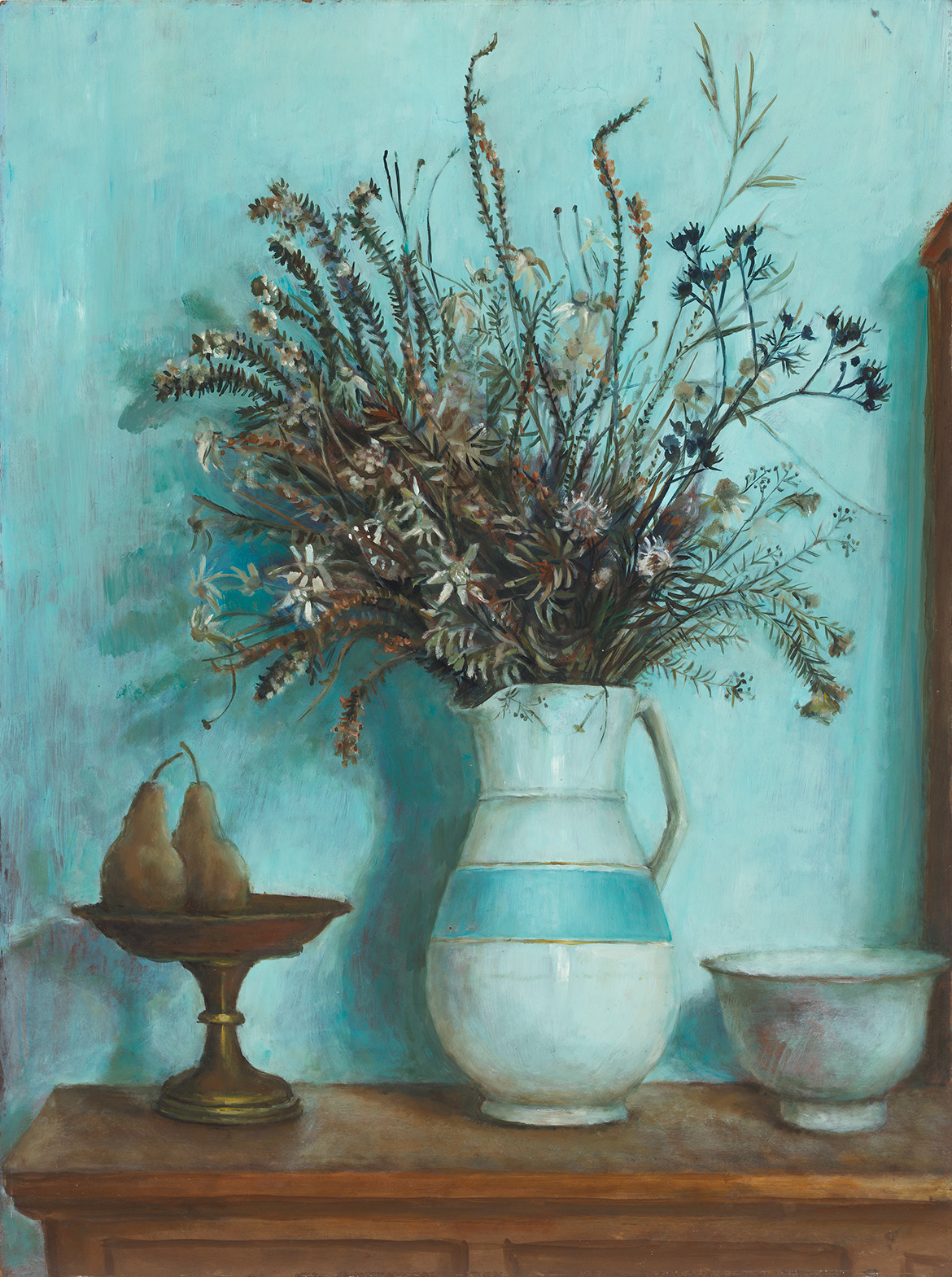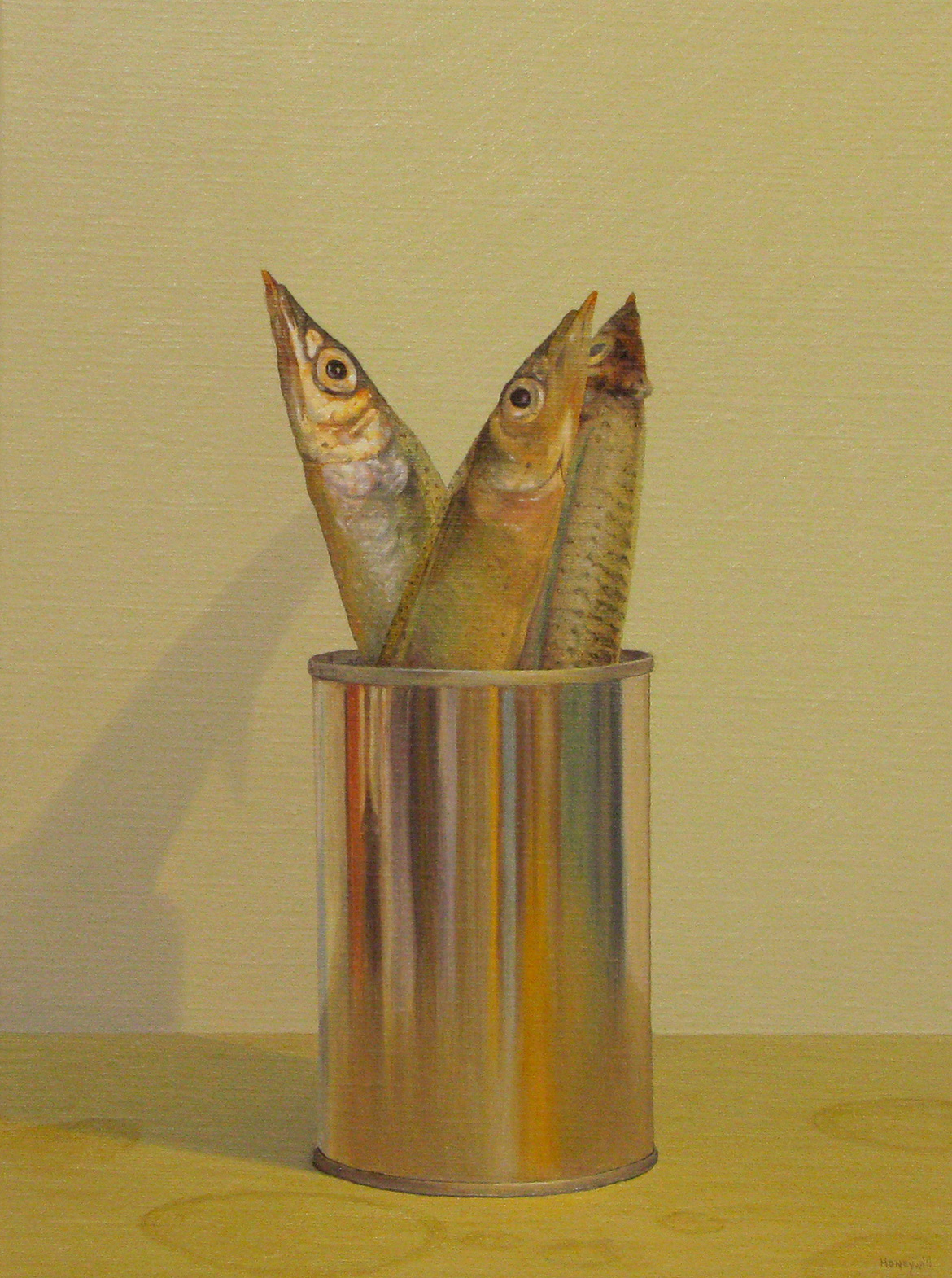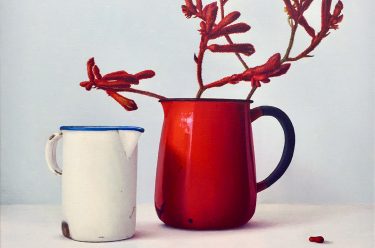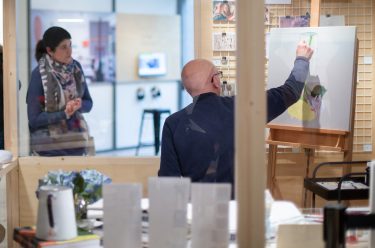As the first guest artist for the Open Studio project at the Queensland Art Gallery, John Honeywill was invited to select artworks from the QAGOMA collection through which to share insights into his practice. As we continue our Open Studio series, we delve into this still life artist and his interest in the relationships between objects and the way that we relate to them. Honeywill views the idea of objects having conversations is something that occurs at an early age and is present in the composition of still life works.
Objects have conversations: John Honeywill
Kirsten Coelho and John Honeywill were both engaged as artists in residence at the Margaret Olley Art Centre at the Tweed Regional Art Gallery. While Coehlo is a ceramicist and Honeywill a painter, they both explore the relationships between objects and the ways that subtle compositional variations can evoke distinct responses from viewers.
Margaret Olley ‘Hawkesbury wildflowers and pears’ c.1973

John Honeywill ‘ Jug and artichoke flower’ 2018

Honeywill has explored the playful and quirky potential of the still life genre. For instance, during the years of raising his sons Honeywill’s selection of objects, titling of artworks and compositional choices were particularly playful. While some of the humour may go unnoticed, there is an undeniable sense of joy across the artist’s oeuvre.
Watch | John Honeywill
Watch | Kirsten Coelho
Kirsten Coelho, Denmark/Australia b.1966 / Abide 2018 / Porcelain, matte white celadon glaze, iron oxide / Three pieces: 21 x 29 x 22cm (overall) / Purchased 2019. Andrew and Lilian Pedersen Trust / Collection: Queensland Art Gallery | Gallery of Modern Art / © Kirsten Coelho
A sense of quirkiness: John Honeywill
Honeywill’s selection of artwork from the QAGOMA collection, draws attention to the capacity of contemporary artists to portray the absurdity of our relationship to objects is not often associated with the genre of still life. In Stuart Ringholt’s Double pencil 2009 and Double cigarette 2009 the use of ready-made objects – altered in form and function – echoes the interests of the Dadaists. Honeywill as an artist and educator invites art lovers to consider the fullest scope of still life as a genre that can include the humour of Ringholt and the matchbox references to the Bauhaus presented with intricate detail by Eugene Carchesio.
John Honeywill ‘Tinned fish’ 2009

Stuart Ringholt ‘Double pencil’ 2008
Stuart Ringholt, Australia b.1971 / Double pencil 2008 / Painted wood and graphite on wooden presentation box: Object: 0.7 x 10.9 x 0.7cm; presentation box: 4.1 x 16.6 x 5.2cm (complete) / Purchased 2011. Ivy Lillian Walton Bequest / Collection: Queensland Art Gallery | Gallery of Modern Art / © Stuart Ringholt
Eugene Carchesio ‘Interpreter’ 1993-94
Eugene Carchesio, Australia b.1960 / Interpreter 1993-94 / Cardboard, paper and typing correction fluid: 40 matchboxes: 6.5 x 4.5 x 3cm (each, approx.); 99.5 x 106.5 x 12.5cm (installed in frame) / Purchased 1995 under the Contemporary Art Acquisition Program with funds from Dr Paul Eliadis through the Queensland Art Gallery Foundation / Collection: Queensland Art Gallery | Gallery of Modern Art / © Eugene Carchesio
A sense of stillness: John Honeywill
While Honeywill’s selection of a Kirsten Coelho’s Abide 2018 and Gwyn Hanssen Pigott’s Three inseparable bowls c.1988-89 speak to his interest in stillness, others like Vida Lahey’s Art and nature 1934 and David Strachan’s Still life flowers and oranges 1967 highlights his appreciation of artists who work with light as a key element in the construction of a still life scene.
The white-upon-white of Lahey’s watercolour is both high in saturation and vivid in radiant colouration. While the green hue of Strachan’s prickly composition is at once intriguing and inhospitable. The interplay of light upon the objects is what sets the scene and enables viewers to experience something more than a technical representation of forms occupying space.
Watch | While Honeywill
Vida Lahey ‘Art and nature’ 1934
Vida Lahey, Australia 1882-1968 / Art and nature 1934 / Watercolour over pencil on cardboard / 52.5 x 60.6cm / Gift of the Queensland Art Fund 1950 in memory of Miss Madge Roe (1891-1938) / Collection: Queensland Art Gallery | Gallery of Modern Art / © QAGOMA
David Strachan ‘Still life flowers and oranges’ 1967
David Strachan, Australia 1919-1970 / Still life flowers and oranges 1967 / Oil on composition board / 52 x 64.5cm / Gift of Julie O’Duffy in memory of Dr John and Mrs Rita O’Duffy through the Queensland Art Gallery Foundation 2012. Donated through the Australian Government’s Cultural Gifts Program / Collection: Queensland Art Gallery | Gallery of Modern Art / © Estate of David Strachan
Minimal space: John Honeywill
The impact of light upon a scene is as much about the subject as it is the space around the objects – the background, the in-between, the negative space. A balance of harmony and tension exists between light, colour, form, ground, shadow and reflection across the entirety of a painting’s surface.
While considering the control required for John Honeywill to execute a well-balanced painting that leaves open a generous amount of negative space, there is value in learning from a printmaker to be influential to this aspect of his aesthetic.
Marigolds 1975 by David Rose is one such work by the printmaker Honeywill looked to as a point of reference for embracing minimal space. Rose allows for the chance imperfections of printmaking room to play out across the vast open field surrounding the marigolds.
The presence of minimal space as a key visual element in still life can be grasped across mediums. Be it a print, a watercolour, an oil painting or meticulously spaced ceramic forms, the gravitas of minimal space is on display in John Honeywill’s selections.
Watch | While Honeywill
David Rose ‘Marigolds’ 1976
David Rose, Australia b.1936 / Marigolds 1976 / Etching on BFK Rives paper / 60.6 x 45.1cm (comp.) / Purchased 1976 / Collection: Queensland Art Gallery | Gallery of Modern Art / © David Rose
Reading List
For Open Studio, John Honeywill selected these books on the artists who inspired him. To read, research or learn more about these artists, visit the QAGOMA Research Library.
Laura Mattioli and others. Giorgio Morandi: Late Paintings. David Zwirner, New York, 2017.
Paul Hills. Brice Marden. Rizzoli International Publications, New York, 2018.
Donald Woodman. Agnes Martin and Me. Lyon Artbooks, New York, 2016.
Chris Bedson. Euan Uglow: Sargy Mann. John Rule, 2017.
Michael Hawker and others. Margaret Olley – A Generous Life. QAGOMA, Brisbane, 2019
Watch | Meet John Honeywill
QAGOMA Research Library
The QAGOMA Research Library is located on Level 3 of the Gallery of Modern Art (GOMA). Open to the public Tuesday to Friday 10.00am to 5.00pm. visit us in person or explore the online catalogue. Access to special collections is available by appointment.
Featured image detail: Vida Lahey Art and nature 1934
#QAGOMA


